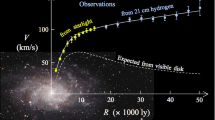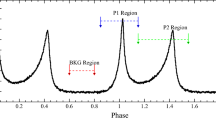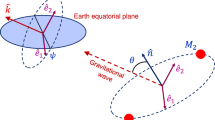Abstract
This work presents an analytical approach for studying the cosmological 21cm background signal from the Dark Ages (DA) and subsequent Epoch of Reionization (EoR). We simulate differential observations of a galaxy cluster to demonstrate how these epochs can be studied with a specific form of the Sunyaev-Zel’dovich Effect called the SZE-21cm. This work produces simulated maps of the SZE-21cm and shows that the SZE-21cm can be extracted from future observations with low-frequency radio interferometers such as the Hydrogen Epoch of Reionization Array (HERA) and the Square Kilometre Array (SKA). In order to simulate near realistic scenarios, we look into cosmic variance noise, incorporate and take into account the effects of foregrounds, thermal noise, and angular resolution for our simulated observations. We further extend this exploration by averaging over a sample of galaxy clusters to mitigate the effects of cosmic variance and instrumental noise. The impact of point source contamination is also studied. Lastly, we apply this technique to the results of the EDGES collaboration, which in 2018 reported an absorption feature of the global 21cm background signal centred at 78 MHz. The challenges to be addressed in order to achieve the objectives of this work include errors that arise due to cosmic variation, instrumental noise and point source contamination. Our approach demonstrates the potential of the SZE-21cm as an indirect probe for the DA and EoR, and we conclude that the spectral features of the SZE-21cm from our simulated observations yield results that are close to prior theoretical predictions and that the SZE-21cm can be used to test the validity of the EDGES detection.









Similar content being viewed by others
References
Ade, P.A.R., Aghanim, N., Arnaud, M., Ashdown, M., Aumont, J., Baccigalupi, C., Banday, A.J., Barreiro, R.B., et al. (Planck Collaboration): ArXiv e-prints (2015). 1502.01589
Barkana, R.: Nature 555, 71–74 (2018)
Barkana, R., Leob, A.: Astrophys. J. 626, 1 (2005)
Birkinshaw, M.: Phys. Rep. 310, 97 (1999)
Bowman, J.D., Morales, M.F., Hewitt, J.N.: Astrophys. J. 695, 183 (2009)
Bowman, J.D., Rogers, A.E.E., Monsalve, R.A., Mozdzen, T.J., Mahesh, N.: Nature (London) 555, 67 (2018)
Bradley, R.F., Tauscher, K., Rapetti, D., Burns, J.O.: Astrophys. J. 874, 153 (2019)
Bromm, V., Yoshida, N., Hernquist, L., McKee, C.F.: Nature 459, 49–54 (2009)
Burns, J.O., Lazio, J., Bowman, J., Bradley, R., et al.: Adv. Space Res. 218, 233.03 (2011)
Carlstrom, J.E., Holder, G.P., Reese, E.D.: Annu. Rev. Astron. Astrophys. 40, 643–680 (2002)
Cavaliere, A., Fusco-Femiano, R.: A & A 49, 137 (1976)
Clanton, C., Beichman, C., Vasisht, G., Smith, R., Gaudi, B.S.: Astron. Soc. Pac. 124, 917 (2012)
Colafrancesco, S., Marchegiani, P., Palladino, E.: Astron. Astrophys. 397, 27 (2002)
Colafrancesco, S., Marchegiani, P., Emritte, M.S.: Astron. Astrophys. 595, A21 (2016)
Cooray, A.R.: Phys. Rev. D 73, 103001 (2006)
Cooray, A.R., Grego, L., Holzapfel, W.L., Joy, M., Carlstrom, J.E.: Astron. J. 115, 1388 (1998)
DeBoer, D.R., Parsons, A.R., Aguirre, J.E., et al.: Publ. Astron. Soc. Pac. 129, 974 (2017)
Enßlin, T.A., Kaiser, C.R.: A & A 360, 417–430 (2006)
Ewall-Wice, A., Chang, T.C., Lazio, J., Doré, O., Seiffert, M., Monsalve, R.A.: Astrophys. J. 868, 63 (2018)
Ewen, H., Purcell, E.: Nature 168, 356 (1951)
Fan, X.: Astron. J. 132, 117 (2006)
Feretti, L., Giovannini, G., Govoni, F., et al.: Astron. Astrophys. Rev. 120, 54 (2012)
Fialkov, A., Barkana, R., Cohen, A.: Phys. Rev. Lett. 121, 011101 (2018)
Field, G.: Astrophys. J. 129, 536 (1958)
Fixsen, D.J., Kogut, A., Levin, S., Limon, M., Lubin, P., Mirel, P., Seiffert, M., Singal, J., Wollack, E., Villela, T., Wuensche, C.A.: Astrophys. J. 734, 5 (2011)
Furlanetto, S.R.: Mon. Not. R. Astron. Soc. 371, 867–878 (2006)
George, L.T., Dwarakanath, K.S., Johnston-Hollitt, M.: Mon. Not. R. Astron. Soc. 467, 936–949 (2017)
Hansen, S.H., Pastor, S., Semikoz, V.S.: Astrophys. J. 573, L69–L71 (2002)
Hassan, S., Liu, A., Kohn, S., La Plante, P.: Mon. Not. R. Astron. Soc. 483, 2524 (2018)
Hills, R., Kulkarni, G., Meerburg, P.D., et al.: Nature 564, E32–E34 (2018)
Holder, G.P.: Astrophys. J. 580, 36–41 (2002)
Holder, G.P., Carlstrom, J.E.: ASP Conf. Ser. 181, 199 (1999)
Jacobs, D.C.: Astrophys. J. 801(1), 51 (2015)
Jacobs, D.C.: Astrophys. J. 825(2), 114 (2016)
Liu, A., Tegmark, M., Zaldarriaga, M.: Mon. Not. R. Astron. Soc. 394, 1575 (2009)
Liu, A., Parsons, A.R., Trott, C.M., et al.: Phys. Rev. D 90, 023018 (2014)
Liu, A., Pritchard, J.R., Allison, R., et al.: Phys. Rev. D 93, 043013 (2016)
McKinley, B., Bernardi, G., Trott, C.M., Line, J.L.B., Wayth, R.B., Offringa, A.R., Pindor, B., Jordan, C.H., Sokolowski, M., Tingay, S.J., et al.: Mon. Not. R. Astron. Soc. 481, 5043–5045 (2018)
McQuinn, M., et al.: Astrophys. J. 653, 815 (2006)
Mebane, R.H., Mirocha, J., Furlanetto, S.R.: Mon. Not. R. Astron. Soc. 493(1), 1217–1226 (2020)
Mellema, G., Koopmans, L., Abdalla, F., Bernardi, G., Ciardi, B., Daiboo, S., de Bruyn, G., Datta, K.K., Falcke, H., Ferrara, A., et al.: ArXiv e-prints (2012). 1210.0197
Mesinger, A., Furlanetto, S.R., Cen, R.: Mon. Not. R. Astron. Soc. 411, 955–972 (2010)
Mohan, N., Rafferty, D.: PyBDSM: Python Blob Detection and Source Measurement. Astrophysics Source Code Library (2015)
Mondal, R., Shaw, A.K., Iliev, I.T., Bharadwaj, S., Datta, K.K.: Mon. Not. R. Astron. Soc. 494(3), 4043–4056 (2019)
Muller, C., Oort, J.: Bull. Astron. Inst. Neth. 13, 151 (1957)
Paciga, G., Albert, J.G., Bandura, K., et al.: Mon. Not. R. Astron. Soc. 443, 639–647 (2013)
Pober, J.C., Parsons, A.R., DeBoer, D.R., et al.: Astron. J. 145, 65 (2013)
Pober, J.C., Liu, A., Dillon, J.S., et al.: Astrophys. J. 782, 66 (2014)
Pritchard, J.R., Loeb, A.: Rep. Prog. Phys. 75, 086901 (2012)
Rephaeli, Y.: Annu. Rev. Astron. Astrophys. 33(1), 541–579 (1995)
Romer, A.K., et al.: Astrophys. J. 547(2), 594–608 (2001)
Santos, M., Cooray, A., Knox, L.: Astrophys. J. 625, 575–587 (2005)
Shaver, P.A., Windhorst, R.A., Madau, P., de Bruyn, A.G.: Astron. Astrophys. 345, 380–390 (1999)
Sims, P.H., Pober, J.C.: Mon. Not. R. Astron. Soc. 488, 2904–2916 (2019a)
Sims, P.H., Pober, J.C.: Mon. Not. R. Astron. Soc. 492, 22–38 (2019b)
Singh, S., Subrahmanyan, R.: Astrophys. J. 880, 26 (2019)
Sunyaev, M., Zel’dovich, Y.: Comments Astrophys. Space Phys. 2, 66 (1970)
Sunyaev, M., Zel’dovich, Y.: Comments Astrophys. Space Phys. 4, 173 (1972)
Sunyaev, M., Zel’dovich, Y.: Annu. Rev. Astron. Astrophys. 18, 537 (1980)
Takalana, C.M., Colafrancesco, S., Marchegiani, P.: In: PoS HEASA2017, p. 008 (2018)
van de Hulst, H.C.: Ned. Tijdschr. Natuurkd. 11, 210 (1945)
Wise, J.H.: Contemp. Phys. 60, 145 (2019)
Zaldarriaga, M., Furlanetto, S., Hernquist, L.: Astrophys. J. 608, 622 (2004)
Zaroubi, S.: The First Galaxies – Theoretical Predictions and Observational Clues, vol. 396. Springer, Berlin (2013)
Zel’dovich, Y., Sunyaev, R.: Astrophys. Space Sci. 4, 301 (1969)
Acknowledgements
The South African Radio Astronomy Observatory (SARAO), which is a facility of the National Research Foundation (NRF), a Department of Science and Innovation (DSI) agency, has sponsored this research. C.M., P.M. & G.B. acknowledge the encouragement, advice and supervision of Prof. Sergio Colafrancesco in this work, may his soul rest in peace.
Author information
Authors and Affiliations
Corresponding author
Additional information
Publisher’s Note
Springer Nature remains neutral with regard to jurisdictional claims in published maps and institutional affiliations.
S. Colafrancesco is deceased: 30 September 2018.
Rights and permissions
About this article
Cite this article
Takalana, C.M., Marchegiani, P., Beck, G. et al. Simulated differential observations of the Sunyaev-Zel’dovich effect: probing the dark ages and epoch of reionization. Astrophys Space Sci 365, 188 (2020). https://doi.org/10.1007/s10509-020-03902-6
Received:
Accepted:
Published:
DOI: https://doi.org/10.1007/s10509-020-03902-6




